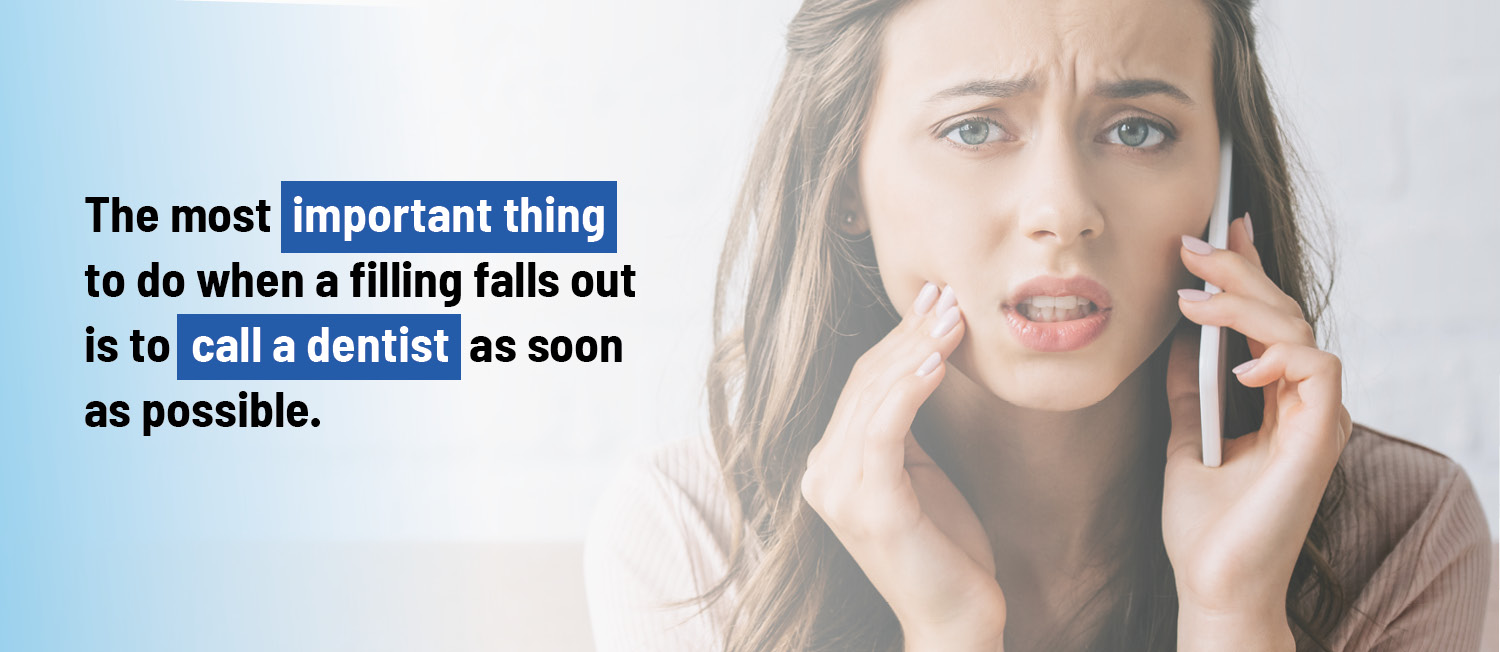Tooth fillings are common in adults. According to the National Institute of Dental and Craniofacial Research, an adult aged 20-34 has about 5 fillings in their teeth and this number only increases with age. Considering that fillings have a limited lifespan, it’s not surprising that at some point in their lives, some people will have to deal with a tooth filling that has fallen out. To prevent panic, it is helpful to know what action to take when this happens, and if it can be prevented.
Why Do Fillings Fall Out?
No dental filling is meant to last forever. There are a handful of reasons why a dental filling will fall out.
Age
Dental fillings that have been in place for a long time are more likely to fall out. This is simply due to the normal wear and tear from eating over time. Most dental fillings should last at least 5 years, and some last up to 30 years, depending on the type of material. For example, composite fillings are common and only last around 5-7 years. So, those with older composite fillings should see a dentist regularly to check that these fillings are still in place and working properly.
Poorly Done Cavity Filling
Before placing a filling, a dentist will clean out the tooth. In some cases, this may not be done properly and this can cause issues with bonding. The filling may not stick to the tooth or it might debond after a couple of days or weeks, causing the filling to fall out. In most cases, the dentist will fix the problem promptly once they are notified.
Recurrent Decay
Sometimes decay can still occur underneath a filling. This might happen if small leaks or cracks form in the filling material over time and bacteria starts to seep in. When this happens, the filling can fall out.
Clenching and Grinding
The extra pressure from clenching and grinding teeth can affect the integrity of a dental filling, eventually causing it to become loose and fall out.
Trauma
Trauma to a tooth can come in the form of any sudden extreme pressure applied to a small area. This might be anything from a car accident to biting down too hard on a popcorn kernel. Trauma can knock out a tooth filling or cause it to loosen and fall out later.

What To Do When a Tooth Filling Has Fallen Out
The most important thing to do when a filling falls out is to call a dentist as soon as possible. A lost filling leaves an open hole in the tooth, making it more vulnerable to damage and harmful bacteria. This bacteria can cause further decay to the tooth if left untreated. If the tooth becomes more decayed, it may require more extensive work, such as a root canal or extraction, depending on the severity. However, if treated promptly, the filling can simply be replaced. In some cases, a crown might be more appropriate.
Usually, a dentist will be able to schedule an appointment for a lost filling within a couple of days. In the meantime, there might be some pain or sensitivity in the affected tooth. There are a few things that can be done to avoid further damage and pain while waiting for an appointment:
- Avoid crunchy foods.
- Take over-the-counter pain medications, like ibuprofen or acetaminophen.
- Use an ice pack over the affected area.
- Oral topical gels, like Anbesol or Orajel, can be used to numb sensitive teeth and gums.
- Keep the area clean by gentle brushing and gargling with salt water.
- Exposed areas that were covered by the original filling can be temporarily protected by a dental wax.
How to Prevent Fillings From Falling Out
As with most dental problems, the best way to prevent problems is through proper dental care. This means regular brushing and flossing and keeping regular dental appointments. A dentist can detect any issues or wear on fillings early and possibly replace them when there is a higher risk of the tooth filling falling out. Brushing and flossing will help to ward off bacteria and decay which will lessen the likelihood of a filling falling out.
People that clench or grind their teeth should also talk to a dentist about preventative methods, like mouthguards or stress reduction. These can prevent fillings from enduring unnecessary pressure.
How Much Will a Filling Replacement Cost?
Costs are often a concern that can keep people from seeking dental care in a timely manner. Fortunately, replacing a lost filling is less expensive than many dental treatments and it may not cost anything for some patients.
If the filling fell out after a very recent cavity filling, the dentist might fix the problem for free. If it has been a little longer, but still far less than the expected lifetime of the filling and it was not due to any obvious trauma, the dentist might offer a discount. Even for those who are charged the full price, dental insurance can cover a large portion of the bill.
For those without insurance, the cost for a typical dental filling replacement is similar to the original filling. This will depend on the size and type of filling material. On the cheaper end, composite and silver amalgam fillings can cost between $50-$300, while a gold filling can be well over $1000.
Make an Appointment
Every situation is unique and the best way to deal with a tooth filling that has fallen out is to see a dentist as soon as possible. To find a dentist to replace a lost filling or check on existing fillings, contact the Dental Health Society today.


